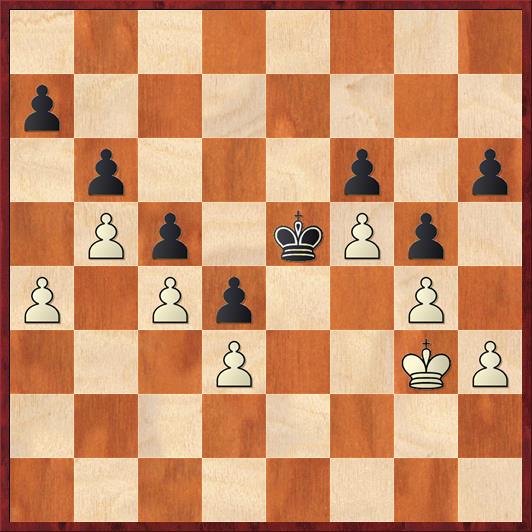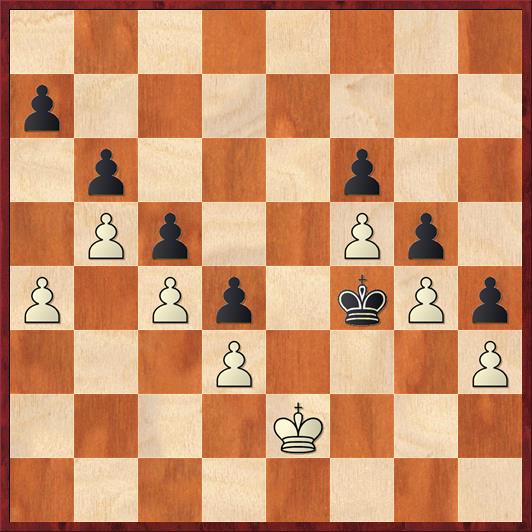Okay, I admit it, I’m a dinosaur. The whole chess world plays online chess, and I don’t. The last time I played online was maybe 15 years ago. But I thought it might be fun to give it another try, especially in the PRO Chess Summer League, competing as part of a team. I was curious to see how this new league would work, with fans competing along with the “pro” players.
So today the San Francisco Mechanics had our first match, against the San Diego Surfers. Sixteen fans against sixteen fans, with two games apiece played at a time control of 10 minutes for the game plus 2 seconds per move. And once again I was reminded of the three reasons that I hate playing chess online: bad play (mostly mine), bad software, and bad sportsmanship.
Let’s start with bad play. In the first game my opponent and I got to this drawn position.

FEN: 8/p7/1p3p1p/1Pp1kPp1/P1Pp2P1/3P2KP/8/8 b – – 0 1
Of course, “drawn” does not mean “drawn under all circumstances.” It means “drawn if both players keep their wits about them.” And I certainly didn’t keep my wits about me.
The simplest way to draw is to simply play 39. … Kd6 and await events. The main thing to realize is that I do not have to do anything active. All I have to do is move my king back and forth between d7 and e7 forever, unless and until White plays Ke4, and then I have to shut him out with … Kd6. White has no way of breaking through against this strategy.
Instead I played 39. … h5?!, which is already courting disaster a little bit. White could try 40. gh Kxf5 41. Kf3 and then Black cannot play the natural-looking 41. … Ke5?? because 42. h6! wins. Instead Black has to play 41. … Ke6, which holds the draw but does require a little bit of calculation.
However, my opponent played 40. Kf3 h4 41. Ke2. And then I made the horrific blunder, 41. … Kf4??
This looks “aggressive” but it is the only way for Black to lose! White seizes the opposition and then squeezes Black’s king backward through the center like toothpaste through a tube. Again, the way to draw was to retreat with 41. … Kd6, heading for the d7-e7 squares.

FEN: 8/p7/1p3p2/1Pp2Pp1/P1Pp1kPp/3P3P/4K3/8 w – – 0 3
Of course my opponent played 42. Kf2, and the rout was on: 42. … Ke5 43. Kf3 Kd6 44. Ke4 Ke7 45. Kd5 Kd7. Even though Black has gotten the opposition back, it matters not because White now plays 46. a5! Ke7 47. ab ab 48. Kc6, breaking through.
This is a super-instructive endgame. Black’s strategy of remaining flexible with the king on d7 and e7, and only coming forward to d6 “in the nick of time” to stop White’s king, is a common idea in king and pawn endgames. What’s galling is that I drew in exactly this way in a tournament game a few years ago, and yet I wasn’t able to retrieve that memory today. And I had no excuse. I still had 5 minutes to play on move 39. I absolutely could have taken my time and figured it out.
So that’s the “bad chess.” I hate online chess because I play badly, partly because the board is only 2-dimensional and I grew up with 3 dimensions, and partly because online chess is always rapid and I’m not very good at rapid chess.
Now the “bad software.” The one thing I was most nervous before the round was that I didn’t know how to offer a draw or resign on chess.com. I asked one of my teammates, and he said that the “Draw” and “Resign” buttons would appear as soon as the game started. And so they did… for the first move at least. I remember noticing them.
But after we got to move 48, and I was ready to resign, I hunted high and low for that “Resign” button and I couldn’t find it anywhere! So I had no choice but to keep on playing.
A word of advice to the programmers: Put the draw and resign buttons in a prominent place, and have them there before the game starts so that a newbie can familiarize himself with where they are.
That brings us to the third part of the equation: “bad sportsmanship.” Okay, I get that my opponent was probably pissed, because I was in a completely lost position and yet I wouldn’t resign. Nevertheless, one has to ask: Does this justify continuing to play on for 99 more moves, capturing all six of my pawns, promoting all six of his pawns to knights, and then running my king on a merry dance around the board with his six knights until the looming 50-move rule forced him to get serious about checkmating me?
It left a really bad taste in my mouth.
Anyway, on to game two. King’s Gambit. I got a great position, and the computer says I was +2.8 pawns at one point, but from then on I played “hope chess” (as in “I hope this sacrifice works”) rather than doing any actual calculation. After sacrificing a piece and then a rook, for no compensation, I would once again have liked to resign. But again, I didn’t know where the button was. So again, I had to sit through about 30 moves of my opponent queening both of his pawns, etc. At least he didn’t make them knights this time.
All in all, it was one of the least pleasant chess experiences I’ve ever had. But I got the last laugh: my team won, 20-12! My 0-2 made no difference, and it wouldn’t have made any difference if I had gone 1½ – ½, which I realistically could have.
As I mentioned in my last post, the fans vs. fans match was only half of the evening’s excitement. The other half is the pros vs. pros part. The way this works is that each of the four teams (Chengdu and St. Louis were also playing) selects one pro player (ours was Daniel Naroditsky). They play a short knockout tournament, with first place scoring 3 points, second 2, and third 1. These scores are added to the 3 points for the winners of the two fan-vs.-fan matches.
I didn’t watch to the end, but Daniel for San Francisco and Varuzhan Akobian for St. Louis won their first matches and faced each other in the finals. So if Danya beat Var, then the Mechanics scored the maximum of 6 points and had a great night. And even if Danya lost, we got 5 points and a pretty good night.


